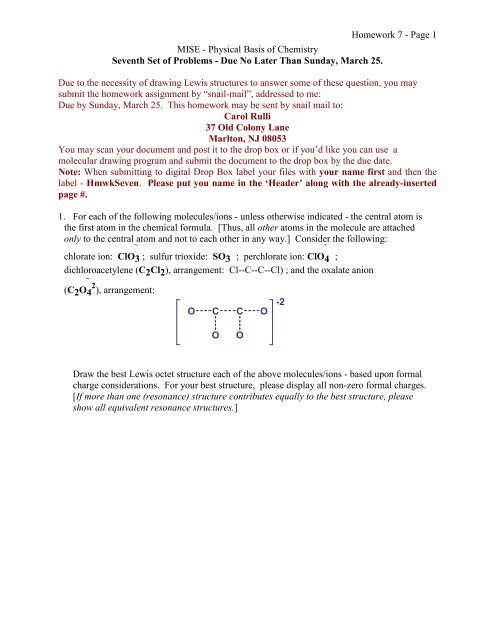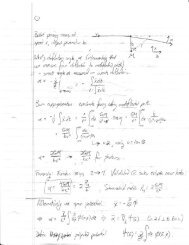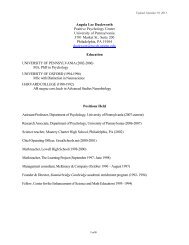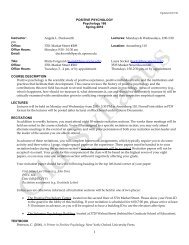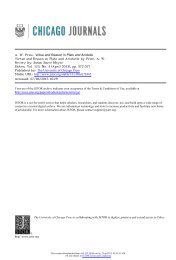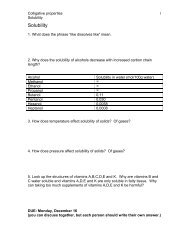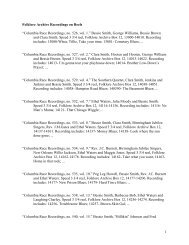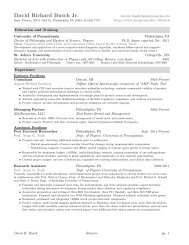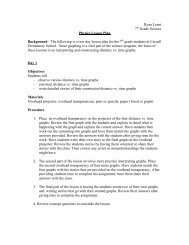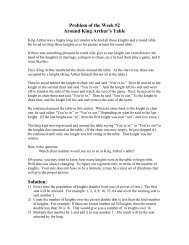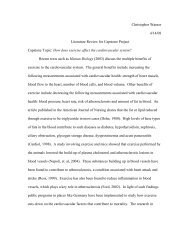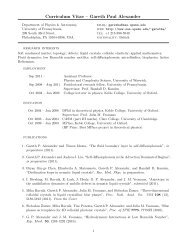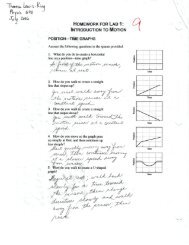Homework 7 - Page 1 MISE - Physical Basis of Chemistry Seventh ...
Homework 7 - Page 1 MISE - Physical Basis of Chemistry Seventh ...
Homework 7 - Page 1 MISE - Physical Basis of Chemistry Seventh ...
Create successful ePaper yourself
Turn your PDF publications into a flip-book with our unique Google optimized e-Paper software.
<strong>MISE</strong> - <strong>Physical</strong> <strong>Basis</strong> <strong>of</strong> <strong>Chemistry</strong><br />
<strong>Seventh</strong> Set <strong>of</strong> Problems - Due No Later Than Sunday, March 25.<br />
<strong>Homework</strong> 7 - <strong>Page</strong> 1<br />
Due to the necessity <strong>of</strong> drawing Lewis structures to answer some <strong>of</strong> these question, you may<br />
submit the homework assignment by “snail-mail”, addressed to me:<br />
Due by Sunday, March 25. This homework may be sent by snail mail to:<br />
Carol Rulli<br />
37 Old Colony Lane<br />
Marlton, NJ 08053<br />
You may scan your document and post it to the drop box or if you’d like you can use a<br />
molecular drawing program and submit the document to the drop box by the due date.<br />
Note: When submitting to digital Drop Box label your files with your name first and then the<br />
label - HmwkSeven. Please put you name in the ‘Header’ along with the already-inserted<br />
page #.<br />
1. For each <strong>of</strong> the following molecules/ions - unless otherwise indicated - the central atom is<br />
the first atom in the chemical formula. [Thus, all other atoms in the molecule are attached<br />
only to the central atom and not to each other in any way.] Consider the following:<br />
chlorate ion: ClO<br />
3 ; sulfur trioxide: SO 3 ; perchlorate ion: ClO<br />
4 ;<br />
dichloroacetylene (C 2 Cl 2 ), arrangement: Cl--C--C--Cl) ; and the oxalate anion<br />
(C 2 O 4<br />
2 ), arrangement:<br />
O C<br />
O<br />
C<br />
O<br />
O -2<br />
Draw the best Lewis octet structure each <strong>of</strong> the above molecules/ions - based upon formal<br />
charge considerations. For your best structure, please display all non-zero formal charges.<br />
[If more than one (resonance) structure contributes equally to the best structure, please<br />
show all equivalent resonance structures.]
Trigonal bent less than 120 degrees for ClO 3<br />
<strong>Homework</strong> 7 - <strong>Page</strong> 2
Trigonal bent less than 120 degrees for SO 3<br />
<strong>Homework</strong> 7 - <strong>Page</strong> 3
<strong>Homework</strong> 7 - <strong>Page</strong> 4
<strong>Homework</strong> 7 - <strong>Page</strong> 5
<strong>Homework</strong> 7 - <strong>Page</strong> 6<br />
2. For the chlorate ion, sulfur trioxide, and the perchlorate ion, predict the (ideal) geometry<br />
according to the VSEPR model and the steric number <strong>of</strong> the central atom. Write down<br />
the name <strong>of</strong> the ideal geometry (linear, trigonal planar, or tetrahedral) and the ideal<br />
bond angle. Then, determine how the bond angles alter (increase/decrease) due to the<br />
presence <strong>of</strong> lone pair electrons on the central atoms. [Recall that two lone pairs will
alter the ideal bond angle to a greater extent than one lone pair.]<br />
<strong>Homework</strong> 7 - <strong>Page</strong> 7<br />
3. Considering all <strong>of</strong> the molecules/ions in question 1: the chlorate ion, sulfur trioxide, the<br />
perchlorate ion, the oxalate ion, and dichloroacetylene, which are predicted to be polar<br />
and which are predicted to be non-polar? Explain your answers in terms <strong>of</strong> the VSEPR<br />
model and the “pulling” <strong>of</strong> any polar covalent bonds.<br />
(Continued ---->)<br />
4. Draw (best) Lewis structures and use the VSEPR model to answer/explain the following.<br />
[For each <strong>of</strong> the listed molecules below- the central atom is the first atom in the chemical<br />
formula. Thus, all other atoms in the molecule are attached only to the central atom and<br />
not to each other in any way.]<br />
(a) Silicon tetrachloride (SiCl 4 ) and silicon dioxide (SiO 2 ) are predicted to be non-polar<br />
whereas phosphorus trichloride (PCl 3 ) and silicon dichloride (SiCl 2 ) are predicted to<br />
be polar.<br />
Silicon tetrachloride (SiCl 4 ) and silicon dioxide (SiO 2 ) are non-polar because the geometry <strong>of</strong><br />
the molecules cancel out the difference in electro negativity. Phosphorus trichloride (PCl 3 ) and<br />
silicon dichloride (SiCl 2 ) are molecules where the are lone pairs <strong>of</strong> electrons that will not cancel<br />
out the effects <strong>of</strong> the imbalance <strong>of</strong> electro negativity between the atoms.<br />
(b) Intermolecular Forces (IMF’s) are attractive forces that arise between molecules due<br />
to charges polarizing within the molecule. Thus, molecules that are predicted to be<br />
polar (using the VSEPR model) should have stronger IMF’s than non-polar molecules.<br />
[Of course, for the polar molecules, the greater the polarity <strong>of</strong> the individual polar<br />
covalent bonds, the stronger the resultant IMF’s.] A consequence <strong>of</strong> all <strong>of</strong> this is that<br />
properties that are affected by intermolecular forces - such as the liquid ----> gas<br />
boiling temperature (a.k.a. boiling point) - can be rationalized by the relative strengths<br />
<strong>of</strong> these IMF’s. With all <strong>of</strong> the above in mind please answer the following. Be sure<br />
to explain your answers.<br />
(i) Which should have the higher boiling point (b.p.), H 2 S or H 2 O? Explain.<br />
H 2 O should have the higher boiling point. Sulfur having its valence shell on the 3 rd energy<br />
level has a slightly less attraction from the nucleolus. The bonds <strong>of</strong> water should have a greater<br />
attraction due to the greater electro- negativity.<br />
(ii) Arrange the following in order <strong>of</strong> increased boiling point (b.p.). Carefully<br />
explain the reason for your ordering. NF 3 , CF 4 , & PF 3 .<br />
PF 3 should have the highest boiling point due to the biggest disparity in electro-negativity and<br />
paired electrons. CF 4 , should have the lowest boiling point due to its relative low disparity in<br />
electro-negativity and having no lone pairs <strong>of</strong> electrons. NF 3 , comes in between due to its lone<br />
pair <strong>of</strong> electrons and the closeness to the electro-negativity difference between CF 4.


